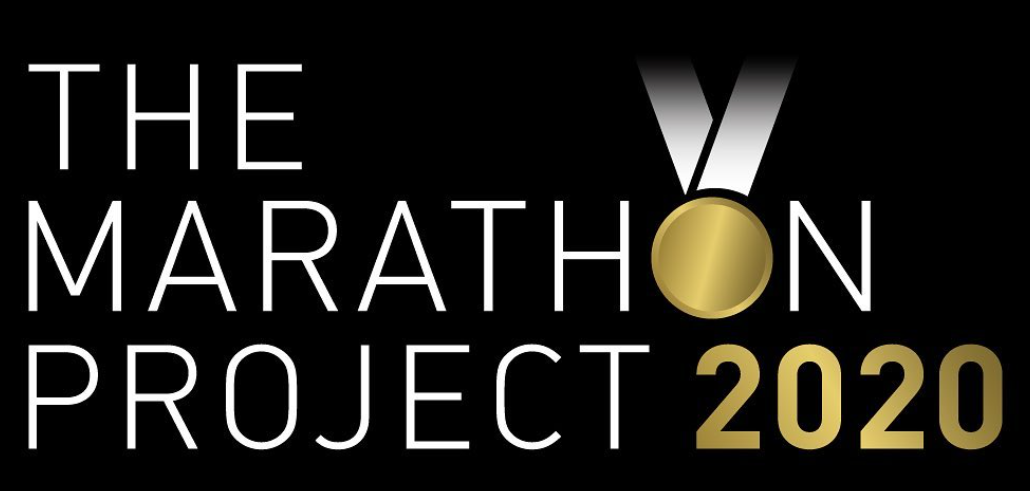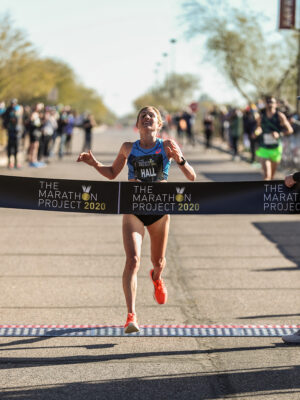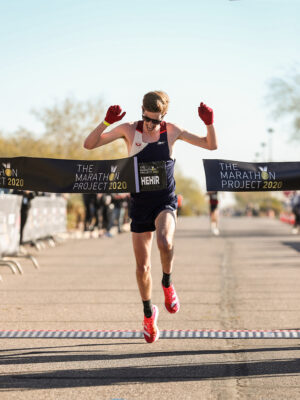Six Final Thoughts About The Marathon Project: 2:09 Isn’t 2:09 Anymore, Des Linden Says America Needs to Join the 2:19 Party, & More
By Jonathan Gault
December 22, 2020
The Marathon Project is in the books, and with it, the 2020 racing season. It was an event American marathoners (and marathon fans) were desperate for after a year rocked by COVID-19, and it was a staggering success. Nothing can replicate the energy, importance, and emotions of the Olympic Marathon Trials held earlier this year, but this was the closest an American event has come to those feelings since that blustery day in Atlanta 10 months ago. London, Valencia, and the World Half were great, but they were also held in the middle of the night in the United States and featured barely any Americans. Watching on Sunday morning, it felt like the largest gathering of US distance fans since the Trials — even if most of that gathering took place on Twitter or the LetsRun messageboards, rather than the barren streets of Chandler, Ariz.
Now that the results are in, it’s time to make sense of it all. And there is a lot to unpack. It has never been harder to analyze marathon results than in the year 2020. What do we make of someone who has never made an Olympic team — or even come close — running the second-fastest marathon ever by an American woman at the age of 37? What do we make of seven men — none of whom finished in the top five at the Trials, and some of whom, I’ll admit, I knew nothing about prior to Sunday — blowing through the 2:10 barrier in the deepest marathon in US history? Celebrating these achievements uncritically seems foolish when there’s a 40-millimeter carbon-fiber-plated elephant standing in the corner of the room. But simply attributing everything to “the shoes” seems cruel when there are so many great stories to tell and individuals to celebrate. Some nuance is required.
So let me provide that nuance. Here’s what stands out in the aftermath of the Marathon Project:
1) The Marathon Project was a smashing success
We know sporting events can be held during a pandemic — just witness the MLB and NFL seasons, the Kentucky Derby, the US Open, etc. It’s just a matter of desire. With the three US-based World Marathon Majors — Boston, Chicago, and New York — declining to stage elite-only events and USATF showing no interest in providing competition opportunities, if there was going to be a serious American marathon this fall, someone else had to step up.
Enter HOKA NAZ Elite coach Ben Rosario and agent Josh Cox. They, along with Big River Race Management’s Matt Helbig, deserve a ton of credit for rescuing the American marathon season and giving almost 100 athletes a target to shoot for in the second half of 2020.
It takes a lot of legwork to pull off an event like this. You’ve got to find a fast course with great weather, then secure the permits, pacers, sponsors, a way to broadcast it, and about a dozen other things. Then you’ve got to actually stage the race. And it largely went off without a hitch. Times were fast, with personal bests were everywhere, so the athletes were happy. The races themselves were compelling, with Martin Hehir making his move to break up a pack of nine at 35k and fending off Noah Droddy over the final miles, and Sara Hall chasing the American record.
The broadcast was one of the best I can recall seeing for a marathon. It helped that there were no wheelchair or mass races to distract from the elite runners, but USATF.TV/NBCSN deserve credit for seamlessly balancing two elite marathons simultaneously. They had cameras with the lead and chase packs for both races, and even broke out a split screen on occasion (more of this please, major marathon producers). They brought back the detailed on-screen leaderboards that were successfully deployed at the Olympic Trials, and the fact that the race was streamed online meant there were no commercials. On the mic, Paul Swangard and Des Linden, in her commentary debut, were terrific. Former athletes can be hit or miss on these broadcasts, but Linden clearly did her homework and the honest, authentic approach that has endeared her to fans translated well to TV. Atlanta Track Club communications ace Jay Holder nailed it:
It’s like @des_linden is sitting next to me at the bar, talking about running. That’s the best kind of color commentating. More of this please. @MarathonProj @runnerspace
— Jay Holder (@jauntingjourno) December 20, 2020
2) Des Linden: “We have to make 2:19 commonplace in America”
Speaking of Des, the most interesting thing she said on the broadcast came at the 30k mark in the women’s race, just as Deena Kastor‘s American record of 2:19:36 — which has stood since 2006 — was beginning to slip away from Hall. Here it is:
Deena’s record is really an era-defining moment in time. I think we’re in a bit of a situation where records are falling down all across the world. We have to get there as well, and I love that Sara’s taking a charge here at this.
2:19 doesn’t necessarily mean what it did when Deena ran it. We’ve seen the depth of women’s running just get stronger and stronger, and we have to match it. We have to make 2:19 commonplace in America. And I really want to see Sara punch through today, close strong, and put us on that next level. There’s a variety of reasons we’re seeing these times fall, but we have to join the party.
Linden couldn’t be more right. When Kastor ran her 2:19:36 in London in 2006, she was the fourth-fastest woman in history and just the eighth woman ever under 2:20. Compare that to the era of super shoes, where 2:19:36 would have made Kastor the sixth-fastest woman…in the 2019 Valencia Marathon.
It used to be that women with 2:19 pbs were guaranteed to be duking it out for major marathon titles. No longer. Of the last 10 World Marathon Majors, seven have been won by women who entered the race with a pb below 2:19 (and that doesn’t include 2020 Tokyo, where the winning time was 2:17:45). Twenty-two of the 28 sub-2:19 marathons in history (79%) have been run in the last four years. We are living in a different era.
That doesn’t mean we should expect to see Americans running 2:17’s and 2:18’s — American marathoners were not among the fastest in the world before the super shoes, so why should we expect them to be among the fastest in the world now? But it does mean that the top Americans need to start closing the gap when it comes to pbs — as Hall is already doing.
Barring another generational talent like Kastor, Americans aren’t going to be able to go toe-to-toe with the world’s best in a flat, fast major anytime soon (Hall was brilliant in London, but was still over three minutes behind winner Brigid Kosgei). But in recent years, Americans like Shalane Flanagan, Linden, and Hall have found success at majors by getting in really good shape, executing a terrific race, and catching a break — whether it’s the world’s best marathoner getting her period on race weekend, a storm for the ages in Boston, or a ton of women going out way too fast in London. That pathway for success is still available. But in an era in which the world record is 2:14:04 and 2:17’s and 2:18’s are becoming increasingly common, “really good shape” for an American now means 2:19 or 2:20 on a fast course — not 2:22 or 2:23.
By the way, the fact that Hall didn’t break Kastor’s record on Sunday is by no means a disappointment. 2:20:32 is a fantastic run, particularly when you remember Hall’s pb was just 2:26:20 as recently as 15 months ago. What Hall is doing, at age 37, is unprecedented by an American marathoner.
3) Some of the men on Sunday have made incredible improvements since their college days
Prior to Sunday, the most Americans that had ever broken 2:10 in the same race came at the 2012 US Olympic Marathon Trials, when four men did it. In the 8+ years since, only six Americans had broken 2:10 (Dathan Ritzenhein, Meb Keflezighi, Galen Rupp (3 times), Jared Ward, Scott Fauble, and Leonard Korir) until Sunday, when seven men accomplished the feat.
Shoe technology has undoubtedly lowered times, but it would be a shame for the shoes to totally overshadow some great stories to emerge from Sunday’s race. Three of the top seven men in Sunday’s race failed to break 14:20 for 5,000 meters in college. I don’t care what shoes you’re wearing: if you can’t break 14:20 in college and wind up breaking 2:10 in the marathon, that’s remarkable. It’s a testament to the relentlessness of the athletes and a credit to the smaller training groups in this country that give athletes an environment to continue pursuing their passion once graduating college. Here are the three men and their stories:
Noah Droddy, 30 years old, 2:09:09 (college pbs: 14:36/29:41)
8th at the NCAA DIII XC champs in 2012 as a senior at DePauw (Ind.), Droddy relocated to Boulder in 2015 to chase the dream under Richard Hansen at Roots Running Project. After becoming a cult hero at the 2016 Olympic Trials, Droddy wound up signing with Saucony in 2017. He ran a pb of 2:11:42 in Chicago last fall and, after scratching from the Olympic Trials due to injury, chopped over two minutes off that time last weekend.
Ian Butler, 29 years old, 2:09:45 (college pbs: 14:46/29:49)
After dealing with memory problems following two serious brain injuries as a young boy, Butler found an outlet in running. That took him to Western State, where he finished 33rd at the NCAA DII XC champs in 2014, and now to the Boulder Harriers, where he trains under marathon legend Steve Jones. Butler didn’t just lower his marathon pb (2:16:26 before Sunday) at the Marathon Project; he also came through the half in 64:28, 54 seconds faster than his previous best.
Mick Iacofano, 26 years old, 2:09:55 (college pbs: 14:26/29:54)
Iacofano never made it to NCAAs at Kentucky (his best finish at the SEC XC champs was 17th as a senior in 2016) but broke out with a 2:13:47 marathon at CIM in 2018. Like Droddy and Butler, that breakout had been preceded by a move to Boulder, where he trained under Brad Hudson. After Hudson’s group disbanded, Iacofano joined Kameron Ulmer‘s Idaho Distance Project. He missed the Trials due to injury, but rebounded in a big way on Sunday.
One more shoutout here to Scott Smith. Though Smith did break 14:20 in college (he ran 13:56/28:35 at UC Santa Barbara) and trains with one of the country’s top marathon groups in NAZ Elite, he deserves props for continuing to get after it well into his 30s. After 10 marathons and two Olympic Trials, Smith finally broke 2:10 in career marathon #11 on Sunday. That’s a lot of lifetime miles on the 34-year-old’s legs, but they paid off last weekend.
4) 2:09 isn’t 2:09 anymore…and there was never an better day to run 2:09 than Sunday
Largely because of the super shoes, which are worth minutes of time, it’s way easier to run sub-2:10 now than it was in 2012. In 2012, 172 men worldwide did it. In 2019, that number went up by nearly 30% to 222. As a result, a 2:09 isn’t as competitive as it was eight years ago — and let’s not fool ourselves and act like 2:09 was super competitive even eight years ago.
And there has never been an easier marathon in history in which to run 2:09* than Sunday’s race. It wasn’t just the super shoes, great conditions, and flat course — it was all of that plus the fact that there was a large group (and two great pacers) running 2:09 pace. Finding a group that large running that fast — but no faster — is rare at major marathons.
“I’ve never seen such a good opportunity to run 2:09,” tweeted two-time Canadian Olympian Reid Coolsaet (who has run 2:10 three times, but never faster). “Usually lead pack too fast for 2:09 attempt.”
*Note: Running 2:09 is still incredibly hard.
I don’t want to piss all over the Americans who ran fast in Arizona. The fact that seven Americans can run 2:09 on the same day is awesome — it’s inspiring to see small school stars like Droddy or Butler find success, to see Iacofano go from 14:26/29:54 pbs in college at Kentucky to running 2:09:55 a few years later. These guys have worked their tails off toiling in obscurity and deserved their moment of glory on Sunday. But the advances in shoe technology over the last few years have forced us to reconsider how we evaluate marathon times. If seven Americans can run 2:09 on one day…well, it tells you 2:09 isn’t 2:09 anymore.
5) Is American men’s marathoning stronger than it was eight years ago?
I mentioned earlier that Sunday’s race surpassed the 2012 Olympic Trials as the race with the most Americans under 2:10. But does that mean American men’s marathoning is actually stronger than it was in 2012?
It depends on how you measure it. If you’re grading American marathoning in terms of depth, then yes. A 2:07 guy couldn’t make the Olympic team in February (Leonard Korir), in a race where 12 guys ran 2:12 or faster on a brutally tough course. Even with the shoes, it does seem as if, 1 through 20, US marathoning is deeper than it was in 2012. And that’s a great thing for domestic races. The Marathon Project didn’t feature any of the top five men from the Olympic Trials, yet it was still a deep, compelling race — and one that, hopefully, birthed some new stars moving forward. Now we have a reason to get genuinely excited when we see Martin Hehir on a start line.
If you grade American marathoning based on contending for the win in majors, however, the US is in about the same spot as it was eight years ago. The record number of 2:09s in Sunday’s race is a good stat to cite from a public relations perspective, but it doesn’t mean much in terms of global competitiveness for US distance running.
The US still has a long way to go to catch up to marathon superpowers Kenya and Ethiopia and even a country like Japan. Galen Rupp remains the only American man capable of challenging for a win at a major marathon. The winner on Sunday in Arizona, Martin Hehir, ran 2:08:59. He is America’s fastest marathoner in all of 2020. That time would have placed him 21st at the Valencia Marathon earlier this month. It would have placed him 25th in Tokyo in March, where 15 men from Japan alone ran faster than 2:08:59. Even with limited racing opportunities, 46 Ethiopians, 21 Kenyans, and 20 Japanese ran faster this year. Hehir is the 111th-fastest marathoner in the world in 2020. The 111th-fastest 5,000 runner ran 13:35. The 111th 1500 runner ran 3:39. Hehir’s pb is 7:20 slower than the world record — that means he’s more than 16 seconds per mile slower than Eliud Kipchoge (16 secs/mile slower than the 5,000 WR is 13:25).
MB: The Marathon Project was a HUGE success, but is Marty Hehir the equivalent of a 13:30 5000 runner?
6) Are adidas’ shoes now the ones to beat?
It took a few years, but most of the major shoe brands have by this point released their answer to Nike’s Vaporflys (or at least distributed prototypes to their sponsored pros). Without a scientific study, we still can’t say for sure whether the sport is on a level playing field. But there is mounting evidence that at least one brand has caught up to Nike — and perhaps exceeded them.
That would be adidas. We already got a taste of what adidas’ adizero Adios Pro could do in Valencia two weeks ago, with Kibiwott Kandie leading the way for the three stripes with a 57:32 half marathon world record. And on Sunday, athletes wearing adidas took two of the top three spots in the men’s race thanks to Hehir and Colin Bennie (Hehir and Bennie run for Reebok, which doesn’t have a super shoe yet, so they were allowed to run in adidas, which owns Reebok). Hehir and Bennie both ran very well at the Olympic Trials (6th and 9th) in blacked-out Vaporflys, so it’s hard to say which shoe is definitively better. But it’s worth noting that, in a competitive field with no clear pre-race favorite, two of the top three wore the same shoe.





